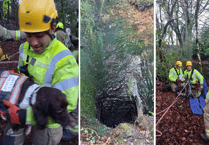A photographer from Bodmin has captured a series of breathtaking images of the galaxy shot over Crowdy Reservoir.
Nerijus Vingevicius’s (Ned) love of photography stemmed from a young age after moving to London at the age of 15 from Lithuania.
Ned explained: “A few years later we moved to Bodmin and it was the first time I’d seen a dark night sky which caught my interest.
“I started taking photos on a mobile phone around 12 years ago until I saved up for my first DSLR camera which allowed me to take long exposures, and this is where it all began, I’d become intrigued in space and seeing deeper in the sky, so I started to research more about astronomy and finally saved up for my first telephoto lens and portable tracking mount.”
Earlier this year, Ned dedicated himself and upgraded his kit, investing in an astrophotography telescope.
More recently, during a frosty week in early January, Ned headed out towards Crowdy Reservoir on Bodmin Moor with his camera to see what he could shoot of the night sky.
Bodmin Moor is well known for its quality of night sky due to little light pollution and in 2017 it was designated an international dark sky landscape.
From this, Ned was able to capture four amazing photos of different parts of the galaxy.
One image captures the Andromeda galaxy – a barred spiral galaxy which is the nearest major galaxy to the Milky Way. The Andromeda has a diameter of around 152,000 light-years and is approximately 2.5-million light-years from Earth.
He also captured The Horsehead Nebula – a small dark nebula in the constellation Orion. The Horsehead Nebula is approximately 1,375 light years from Earth and can be easily identified by its resemblance to a horse’s head.
The third image contains a scene of The Pleiades – an asterism and an open star cluster in the north-west of the constellation Taurus. It is approximately 444 light years away and is one of the nearest star clusters to Earth making it one of the easiest to see with the naked eye in the night sky.
Finally, the fourth image is of NGC 2244 (also known as Caldwell 50 or the Satellite Cluster) – an open cluster in the Rosette Nebula, which is located in the constellation Monoceros. The age of this cluster has been estimated to be less than 5-million years.
Ned explained: “To capture these photos I use Skywatcher Esprit 100 ED telescope combined with Nikon D500 camera mounted on a Skywatcher EQ6-R Pro Equatorial Mount to achieve the best detail as it is one of the darkest sites in Cornwall.
“I then locate my target of the night and leave my camera to continuously capture the longest exposures I can possibly achieve for several hours.
“The following day I import all of the images on to computer and stack them together using a free software called “DeepSkyStacker”, once the stacking is completed, I then load a final stacked image onto “Photoshop” to stretch the data and pull out as many details as I possibly can.”
Ned’s love of the stars has led him to set up an online group called Night Sky Appreciation Cornwall and Devon UK where night sky lovers can post their deep space images, night landscapes, auroras and other celestial events in.




